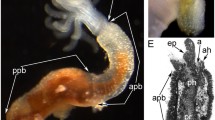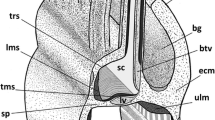Abstract
The plectolophous lophophore, which is an organ characteristic of the order Terebratulida, is the most complex lophophore type in recent brachiopods. In the present paper, we provide the first 3D reconstruction of the coelomic system of the plectolophous lophophore using an example of the terebratulid brachiopod Coptothyris grayi (Davidson, 1852). We have found that this coelomic system consists of three entirely separated compartments. The first compartment includes a periesophageal coelom, as well as paired small and tentacle canals, and performs the transport and excretory functions. The second compartment consists of a pair of large coelomic canals of the lophophore that act as its hydrostatic skeleton. The third compartment is represented by a pair of brachial pouches connected with the perivisceral coelom that contain the diverticula of the digestive gland and allow the efficient use of the mantle cavity.





Similar content being viewed by others
REFERENCES
Valovaya, M.A. and Kavtaradze, D.N., Mikrotekhnika: pravila, priemy, iskusstvo, eksperiment (Microtechnics: Rules, Techniques, Art, and Experiment), Moscow: Mosk. Gos. Univ., 1993.
Kuzmina, T.V., Malakhov, V.V., and Temereva, E.N., Anatomy of coelomic system in the articulate brachiopoda Hemithyris psittacea (Brachiopoda, Articulata), Zool. Zh., 2006, vol. 85, no. 9, pp. 1118–1128.
Kuzmina, T.V. and Malakhov, V.V., Structure of the brachiopod lophophore, Paleonotol. J., 2007, vol. 41, pp. 520–536.
Temereva, E.N. and Malakhov, V.V., The answer to Thomas Bartolomaeus: “Larva of phoronid Phoronopsis harmeri Pixell, 1912 has trimeric coelom organization”, Invertebr. Zool., 2006, vol. 3, no. 1, pp. 1–21.
Temereva, E.N. and Malakhov, V.V., The evidence of metamery in adult brachiopods and phoronids, Invertebr. Zool., 2011, vol. 8, no. 2, pp. 87–101. https://doi.org/10.15298/invertzool.08.2.01
Atkins, D., A new species and genus of Kraussinidae (Brachiopoda) with a note on feeding, Proc. Zool. Soc. London, 1958, vol. 131, no. 4, pp. 559–582.
Atkins, D., The growth stages of the lophophore and loop of the brachiopod Terebratalia transversa (Sowerby), J. Morphol., 1959, vol. 105, no. 3, pp. 401–426.
Atkins, D., The growth stages of the lophophore of the brachiopods Platidia davidsoni (Eudes Deslongchamps) and P. anomioides (Philippi), with notes on the feeding mechanism, J. Mar. Biol. Assoc. U. K., 1959, vol. 38, no. 1, pp. 103–132.
Atkins, D., The early growth stages and adult structure of the lophophore of Macandrevia cranium (Muller) (Brachiopoda, Dallinidae), J. Mar. Biol. Assoc. U. K., 1959, vol. 38, pp. 335–350.
Atkins, D., The ciliary feeding mechanism of the Megathyridae (Brachiopoda), and the growth stages of the lophophore, J. Mar. Biol. Assoc. U. K., 1960, vol. 39, no. 3, pp. 459–479.
Atkins, D., A note on the growth stages and structure of the adult lophophore of the brachiopod Terebratella (Waltonia) inconspicua (G. B. Sowerby), Proc. Zool. Soc. London, 1961, vol. 136, no. 2, pp. 255–271.
Atkins, D., The growth stages and adult structure of the lophophore of the brachiopods Megerlia truncata (L.) and M. echinata (Fischer & Oehlert), J. Mar. Biol. Assoc. U. K., 1961, vol. 41, no. 1, pp. 95–111.
Beecher, C.E., Morphology of the Brachia, Bull. - U. S. Geol. Surv., 1897, vol. 87, pp. 105–112.
Blochmann, F., Untersuchungen über den Bau der Brachiopoden, Die Anatomie von Crania anomala (Müller), Jena: Gustav Fischer, 1892, part 1, pp. 1–65.
Emig, C.C., Functional disposition of the lophophore in living Brachiopoda, Lethaia, 1992, vol. 25, pp. 291–302.
Hancock, A., On the organization of the Brachiopoda, Philos. Trans. R. Soc. London, 1858, vol. 148, pp. 791–869.
Harper, D.A.T., Popov, L.E., and Holmer, L.E., Brachiopods: origin and early history, Palaeontology, 2017, vol. 60, no. 5, pp. 609–631.
Hoverd, W.A., Histological and ultrastructural observations of the lophophore and larvae of the brachiopod, Notosaria nigricans (Sowerby 1846), J. Nat. Hist., 1985, vol. 19, no. 5, pp. 831–850.
Hyman, L.H., The Invertebrates: Smaller Coelomate Groups, New York: McGraw Hill, 1959, pp. 1–783.
Kuzmina, T.V. and Malakhov, V.V., The periesophageal celom of the articulate brachiopod Hemithyris psittacea (Rhynchonelliformea, Brachiopoda), J. Morphol., 2011, vol. 272, no. 2, pp. 180–190.
Kuzmina, T.V., Malakhov, V.V., and Temereva, E.N., Larval development of the brachiopod Coptothyris grayi (Davidson, 1852) (Terebratulida: Rhynchonelliformea) and the evolution of brachiopod life cycles, Invertebr. Zool., 2019, vol. 16, no. 1, pp. 27–40.
Kuzmina, T.V., Ratnovskaya, A.A., and Madison, A.A., Lophophore evolution from the Cambrian to the present, Paleontol. J., 2021, vol. 55, no. 10, pp. 1109–1140.
Kuzmina, T.V., Temereva, E.N., and Malakhov, V.V., Ultrastructure of the lophophoral coelomic lining in the brachiopod Hemithiris psittacea: functional and evolutionary significance, Zoomorphology, 2018, vol. 137, no. 2, pp. 257–272.
Kuzmina, T.V. and Temereva, E.N., Organization of the lophophore in the deep-sea brachiopod Pelagodiscus atlanticus and evolution of the lophophore in the Brachiozoa, Org. Diversity Evol., 2019, vol. 19, pp. 31–39.
Mukai, H., Terakado, K., and Reed, C.G., Bryozoa, Microscopic Anatomy of Invertebrates, vol. 13: Lophophorates, Entoprocta and Cycliophora, New York: Wiley-Liss, 1997, pp. 45–206.
Nielsen, C., The development of the brachiopod Crania (Neocrania) anomala (O. F. Müller) and its phylogenetic significance, Acta Zool., 1991, vol. 72, no. 1, pp. 7–28.
Peck, L.S., Rhodes, M.L., Curry, G.B., et al., Physiology, in Treatise on Invertebrate Paleontology, Part H: Brachiopoda (Revised), vol. 1: Introduction, Lawrence: Kansas Univ., 1997, pp. 213–240.
Percival, E., A contribution to the life-history of the brachiopod Tegulorhynchia nigricans, J. Cell Sci., 1960, vols. s3–101, no. 56, pp. 439–457.
Plandin, F.A. and Temereva, E.N., Anatomy of the coelomic system in Novocrania anomala (Brachiopoda, Craniiformea) and relationships within brachiopods, Zoology, 2021, vol. 144, art. ID 125884. https://doi.org/10.1016/j.zool.2020.125884
Pross, A., Untersuchungen zur Gliederung von Lingula anatina (Brachiopoda). Archimerie bei Brachiopoden, Zool. Jahrb., Abt. Anat. Ontog. Tiere, 1980, vol. 103, pp. 250–263.
Reed, C.G. and Cloney, R.A., Brachiopod tentacles: Ultrastructure and functional significance of the connective tissue and myoepithelial cells in Terebratalia, Cell Tissue Res., 1977, vol. 185, pp. 17–42.
Robinson, J., The muscles, body wall and valve-opening mechanism of extant craniid (inarticulated) brachiopods, J. Nat. Hist., 2014, vol. 48, nos. 21–23, pp. 1231–1252.
Rudwick, M.J.S., Living and Fossil Brachiopods, London: Hutchinson and Co. Ltd., 1970.
Storch, V. and Welsch, U., Elektronenmikroskopische und enzymhistochemische untersuchungen über lophophor und tentakel von Lingula unguis L. (Brachiopoda), Zool. Jahrb., Abt. Anat. Ontog. Tiere, 1976, vol. 96, pp. 225–237.
Temereva, E.N., Organization of the coelomic system in Phoronis australis (Lophotrochozoa: Phoronida) and consideration of the coelom in the lophophorates, J. Zool., 2015, vol. 296, no. 2, pp. 79–94.
Temereva, E.N., Ultrastructure of the coelom in the brachiopod Lingula anatina, J. Morphol., 2017, vol. 278, no. 7, pp. 997–1011.
Temereva, E.N., Gebruk, A.A., and Malakhov, V.V., Demonstration of the preoral coelom in the brachiopod Lingula anatina with consideration of its phylogenetic significance, Zool. Anz., 2015, vol. 256, pp. 22–27.
Temereva, E.N. and Malakhov, V.V., Organization of the epistome in Phoronopsis harmeri (Phoronida) and consideration of the coelomic organization in Phoronida, Zoomorphology, 2011, vol. 130, art. ID 121. https://doi.org/10.1007/s00435-011-0126-z
Williams, A. and Carlson, S.J., Affinities of brachiopods and trends in their evolution, in Treatise on Invertebrate Paleontology, Part H: Brachiopoda (Revised), vol. 6: Supplement, Lawrence: Univ. Kansas Press, 2007, pp. 2822–2877.
Williams, A., Carlson, S.J., Brunton, C.H.C., et al., A supra-ordinal classification of the Brachiopoda, Philos. Trans. R. Soc., B, 1996, vol. 351, no. 1344, pp. 1171–1193.
Williams, A., James, M.A., Emig, C.C., et al., Anatomy, in Treatise on Invertebrate Paleontology, Part H: Brachiopoda (Revised), vol. 1: Introduction, Lawrence: Kansas Univ., 1997, pp. 7–188.
Funding
The study was supported by the Russian Science Foundation, project no. 18-14-00082-P.
Author information
Authors and Affiliations
Corresponding authors
Ethics declarations
Conflict of interests. The authors declare that they have no conflict of interest.
Statement on the welfare of animals. All applicable international, national, and/or institutional guidelines for the care and use of animals were followed.
Additional information
Translated by E. Shvetsov
Rights and permissions
About this article
Cite this article
Ratnovskaya, A.V., Kuzmina, T.V. Organization of the Lophophore Coelomic System in the Brachiopod Coptothyris grayi (Davidson, 1852) (Brachiopoda: Terebratulida). Russ J Mar Biol 48, 266–275 (2022). https://doi.org/10.1134/S1063074022040083
Received:
Revised:
Accepted:
Published:
Issue Date:
DOI: https://doi.org/10.1134/S1063074022040083




